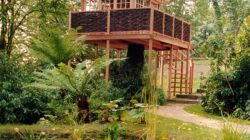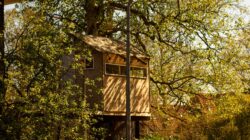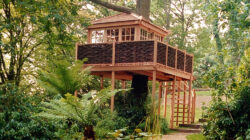Can you get Running Water in a Treehouse?
Can you get Running Water in a Treehouse?
Treehouses evoke a sense of adventure and rustic charm, offering a unique escape into nature’s embrace. While traditional treehouses may lack modern amenities, advancements in design and technology have made it possible to incorporate conveniences such as running water into these elevated dwellings.
1. Structural Considerations
One of the primary challenges of installing running water in a treehouse is ensuring the structural integrity of the treehouse itself. The weight of water tanks, plumbing fixtures, and piping systems can exert significant loads on the treehouse’s supports and branches. Therefore, it’s essential to work with a qualified arborist or structural engineer to assess the tree’s health, stability, and load-bearing capacity before proceeding with any water installation.
2. Water Source
Determining a reliable water source is crucial for supplying running water to a treehouse. Depending on the location and accessibility of the treehouse, options may include connecting to a municipal water supply, drilling a well, or collecting rainwater. Each water source comes with its own set of considerations, such as water quality, availability, and sustainability, which must be evaluated based on the specific needs and circumstances of the treehouse.
3. Plumbing and Drainage
Once a water source has been established, the next step is to design and install a plumbing system that can safely and efficiently deliver water to the treehouse. This may involve running pipes from the water source to the treehouse, installing fixtures such as sinks, showers, and toilets, and implementing drainage systems to manage wastewater. Careful planning and expert craftsmanship are essential to ensure that the plumbing system functions reliably and minimises the risk of leaks or water damage.
4. Heating and Insulation
In colder climates, considerations must be made for heating and insulation to prevent water pipes from freezing and bursting during winter months. Insulating water pipes and incorporating heating elements or heat tracing systems can help maintain water flow and prevent damage to the plumbing system. Additionally, proper insulation of the treehouse itself is essential to ensure occupants’ comfort and protect water fixtures from extreme temperatures.
5. Environmental Impact
Installing running water in a treehouse may have environmental implications that must be carefully considered. For example, wastewater management and treatment are essential to minimise pollution and protect surrounding ecosystems. Implementing eco-friendly practices such as water conservation, greywater recycling, and sustainable landscaping can help mitigate the treehouse’s environmental footprint and promote harmony with nature.
6. Maintenance and Upkeep
Finally, regular maintenance and upkeep are essential to ensure the continued functionality and safety of a treehouse’s water system. Periodic inspections, leak detection, and pipe maintenance are necessary to address any issues promptly and prevent costly damage or disruptions. Additionally, seasonal maintenance tasks such as winterising the plumbing system can help protect against cold weather-related damage and extend the lifespan of the water infrastructure.
While installing running water in a treehouse presents unique challenges, it is indeed feasible with careful planning, expert guidance, and attention to detail. By addressing structural considerations, sourcing water responsibly, designing and implementing a robust plumbing system, and considering environmental impacts, homeowners can enjoy the convenience and comfort of running water in their elevated retreat. With proper maintenance and eco-conscious practices, a treehouse with running water can offer an unparalleled blend of modern luxury and natural beauty, creating a truly magical oasis among the treetops.



